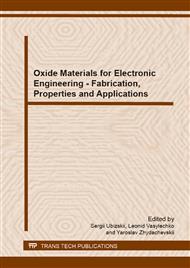[1]
A. Feltz, Amorphous and Vitreous Inorganic Solids, Mir, Moscow, 1986.
Google Scholar
[2]
X. Zhang, H. Ma and J. Lucas, Applications of chalcogenide glass bulks and fibres, J. Optoelelecton. Adv. Mat. 5 (2003) 1327-1333.
Google Scholar
[3]
X. Zhang, B. Bureau, P. Lucas, C. Boussard-Pledel, J. Lucas, Glasses for seeing beyond visible, Chem. Eur. J. 14 (2008) 432-442.
DOI: 10.1002/chem.200700993
Google Scholar
[4]
B. Bureau, X. Zhang, F. Smektala, J.-L. Adam, J. Troles, H. Ma, C. Boussard-Pledel, J. Lucas, P. Lucas, D. Coq, M. Riley, J. Simmons, Recent advances in chalcogenide glasses, J. Non-Cryst. Solids 345&346 (2004) 276-283.
DOI: 10.1016/j.jnoncrysol.2004.08.096
Google Scholar
[5]
J. Keirsse, C. Boussard-Pledel, O. Loreal, O. Sire, B. Bureau, B. Turlin, P. Leroyer, J. Lucas, Chalcogenide glass fibers used as biosensors, J. of Non-Cryst. Solids 326&327 (2003)430-433.
DOI: 10.1016/s0022-3093(03)00434-4
Google Scholar
[6]
O. Shpotyuk, Radiation-induced Effects in Chalcogenide Vitreous Semiconductors, in: R. Fairman and B. Ushkov (Eds), Semiconducting chalcogenide glass I, Elsevier Academic Press: Amsterdam, Boston, London, New York, Oxford, Paris, San Diego, San Francisco, Singapore, Sydney, Tokyo, 2004, pp.215-260.
DOI: 10.1016/s0080-8784(04)80048-6
Google Scholar
[7]
A. Kikineshi, A. Mishak, V. Palyok, M. Shipljak, Nanolayered chalcogenide glass structures for optical recording, NanoStructured Mat. 12 (1999) 417-420.
DOI: 10.1016/s0965-9773(99)00148-8
Google Scholar
[8]
T. Ohta Phase-change optical memory promotes and DVD optical disk, J. Optoelectron. Adv. Mat. 3 (2001) 609-626.
Google Scholar
[9]
O. Shpotyuk, Amorphous chalcogenide semiconductors for dosimetry of high-energy ionizing radiation, Radiat. Phys. Chem. 46 (1995) 1279-1282.
DOI: 10.1016/0969-806x(95)00369-9
Google Scholar
[10]
J.M. Saiter, Physical ageing in chalcogenide glasses, J. Optoelectron. Adv. Mat. 3 (2001) 685-694.
Google Scholar
[11]
O. Shpotyuk, R. Golovchak, H. Jain, A. Kozdras, Radiation-induced physical ageing of the structure of an arsenic–selenide glass, J. Physics and Chemistry of Solids 68 (2007) 901–905.
DOI: 10.1016/j.jpcs.2006.12.002
Google Scholar
[12]
M. Shpotyuk, R. Golovchak, A. Kozdras, O. Shpotyuk, Radiation-induced physical ageing in network arsenic-sulfide/selenide glasses, IOP Conf. Series: Materials Science and Engineering 15 (2010) 012056-1-012056-6.
DOI: 10.1088/1757-899x/15/1/012056
Google Scholar
[13]
Ya. Shpotyuk, V. Balitska, O. Shpotyuk, M. Iovu, Post-irradiation structural relaxation in quasi-binary arsenic/antimony trisulphide glasses, J. Optoelectron. Adv. Mat. 11 (2009) 2079-2082.
DOI: 10.1016/j.jnoncrysol.2010.06.052
Google Scholar
[14]
V. Balitska, Ya. Shpotyuk, J. Filipecki, O. Shpotyuk, M. Iovu, Post-irradiation relaxation in vitreous arsenic/antimony trisulphides, J. Non-Cryst. Sol. 357 (2011) 487-489.
DOI: 10.1016/j.jnoncrysol.2010.06.052
Google Scholar
[15]
R. Golovchak, O. Shpotyuk, A. Kozdras, B.J. Riley, S.K. Sundaram, J.S. McCloy, Radiation effects in physical aging of binary As-S and As-Se glasses, J. Thermal Analysis and Calorimentry 13 (2011) 213-218.
DOI: 10.1007/s10973-010-0876-8
Google Scholar


